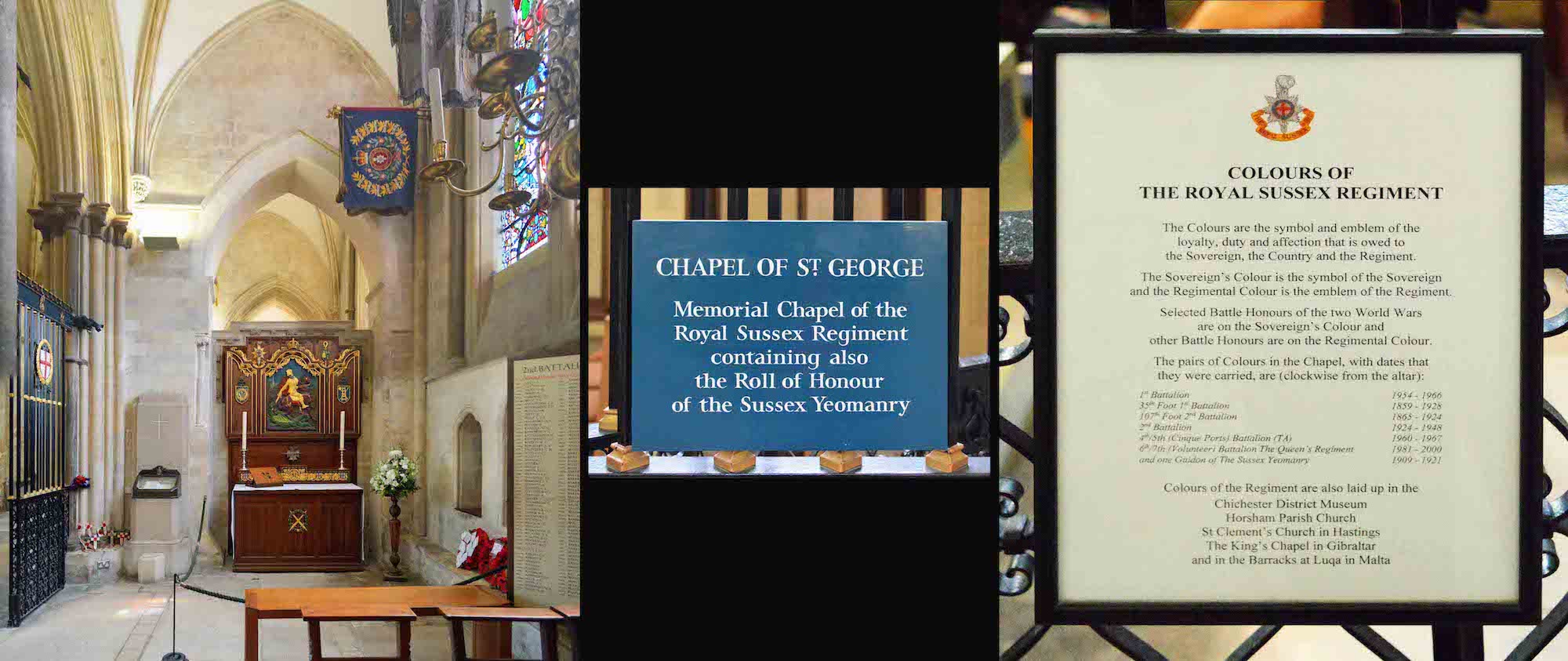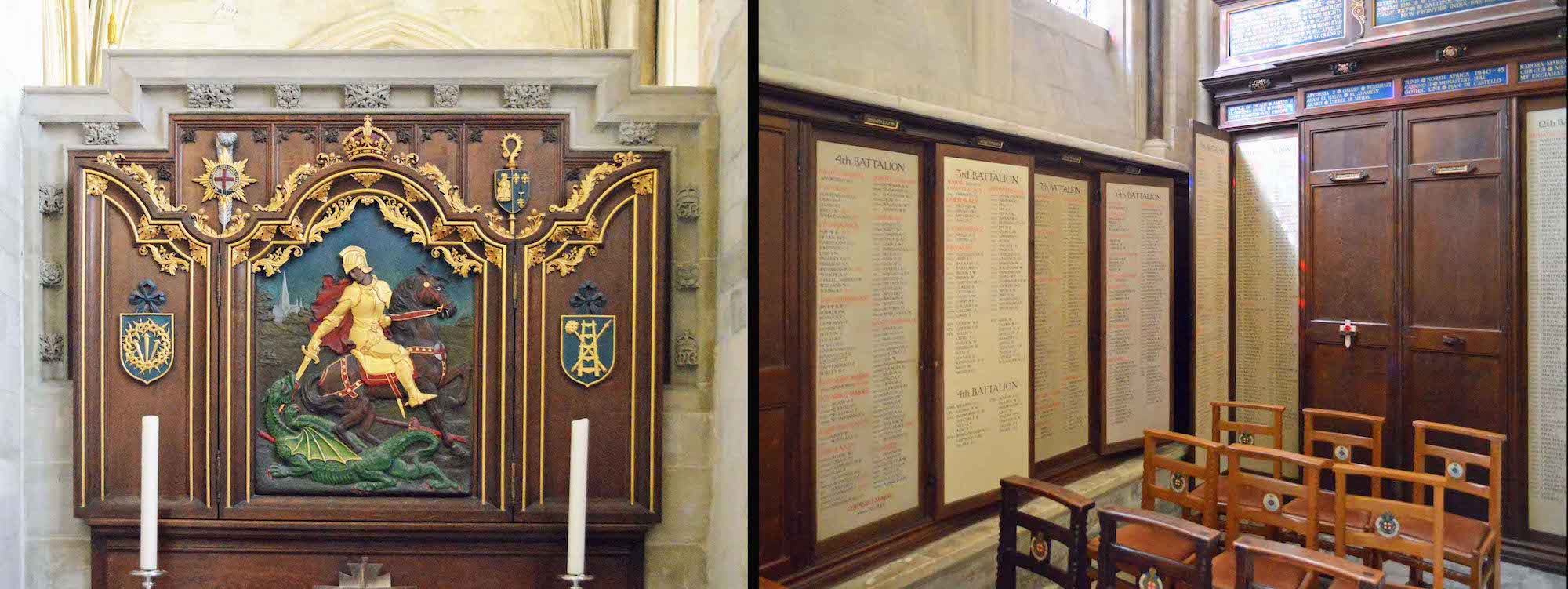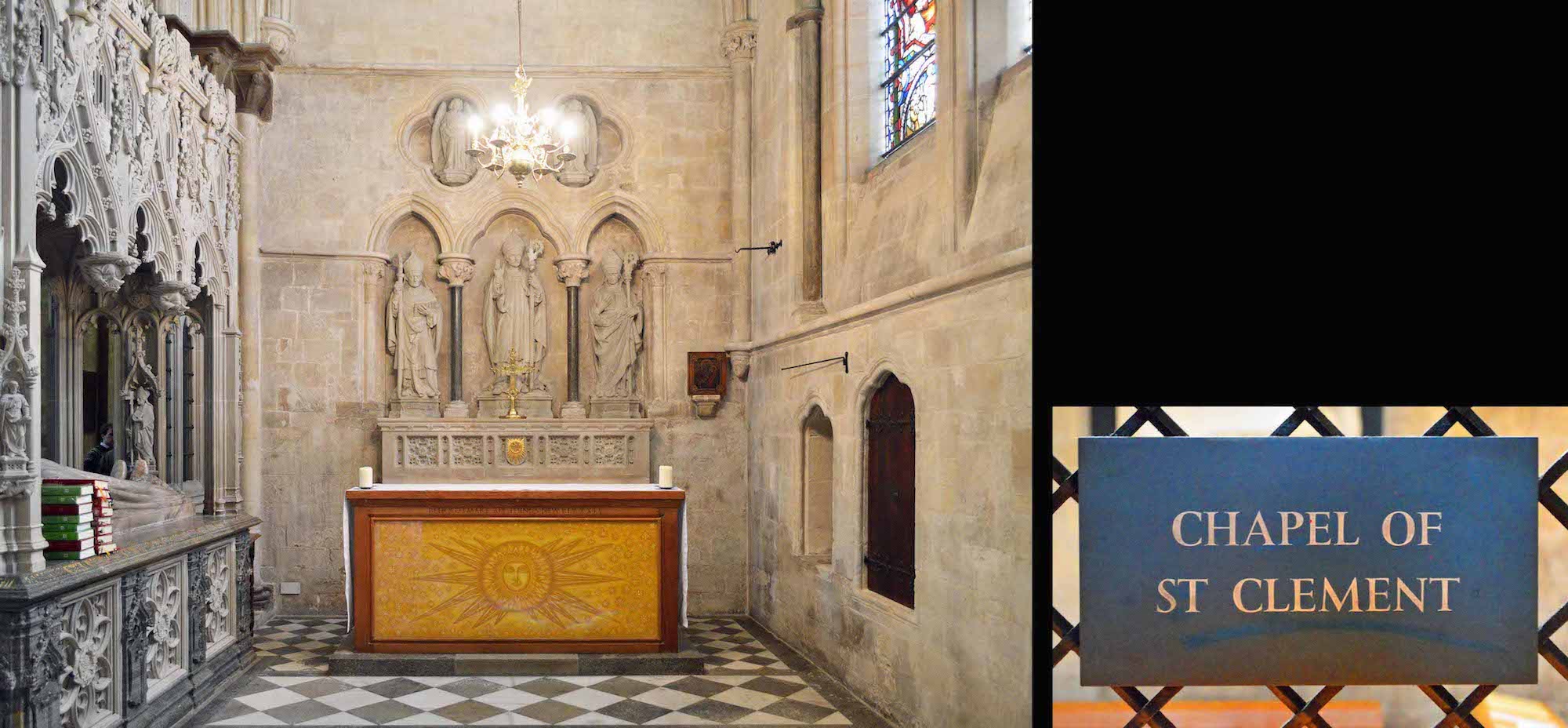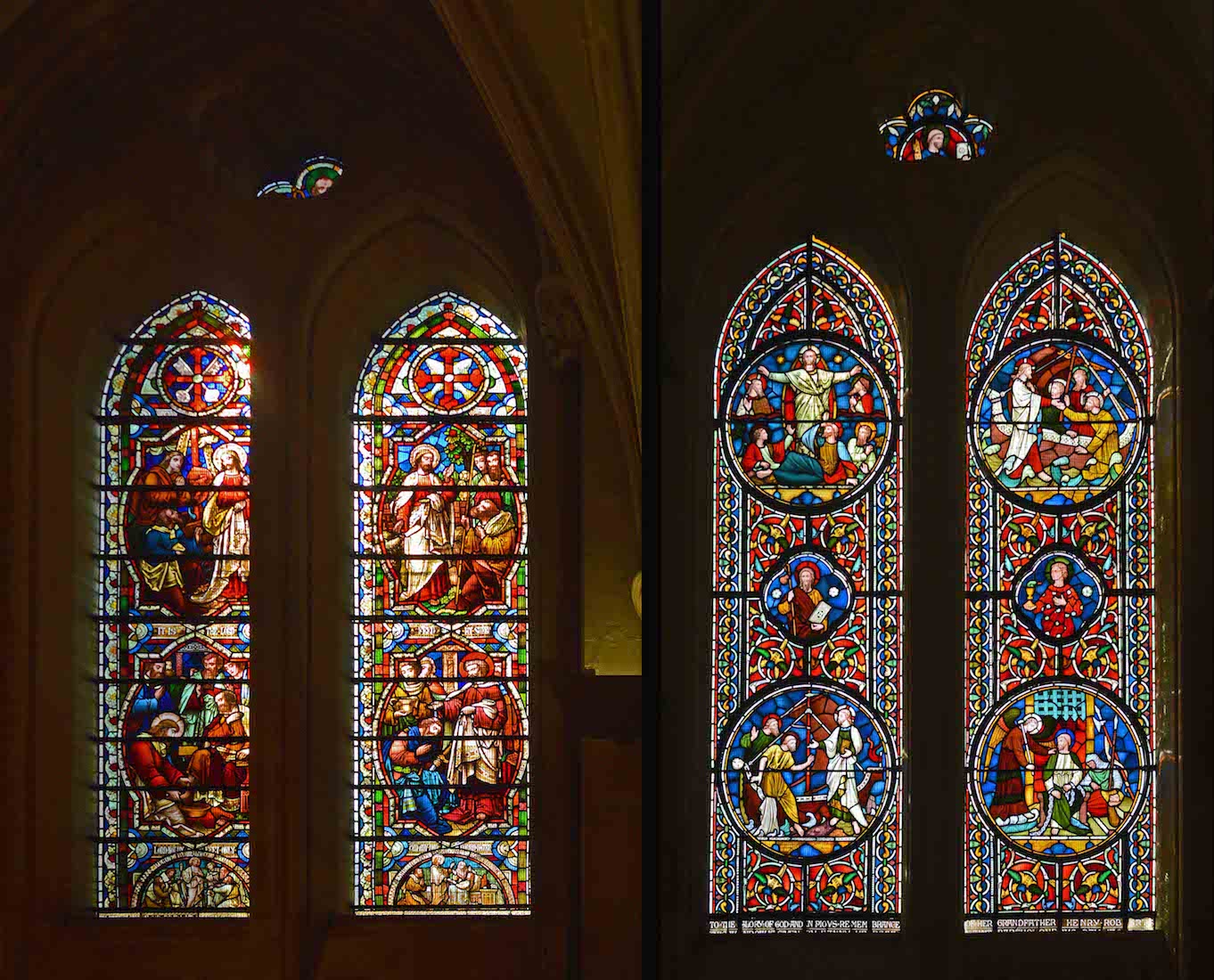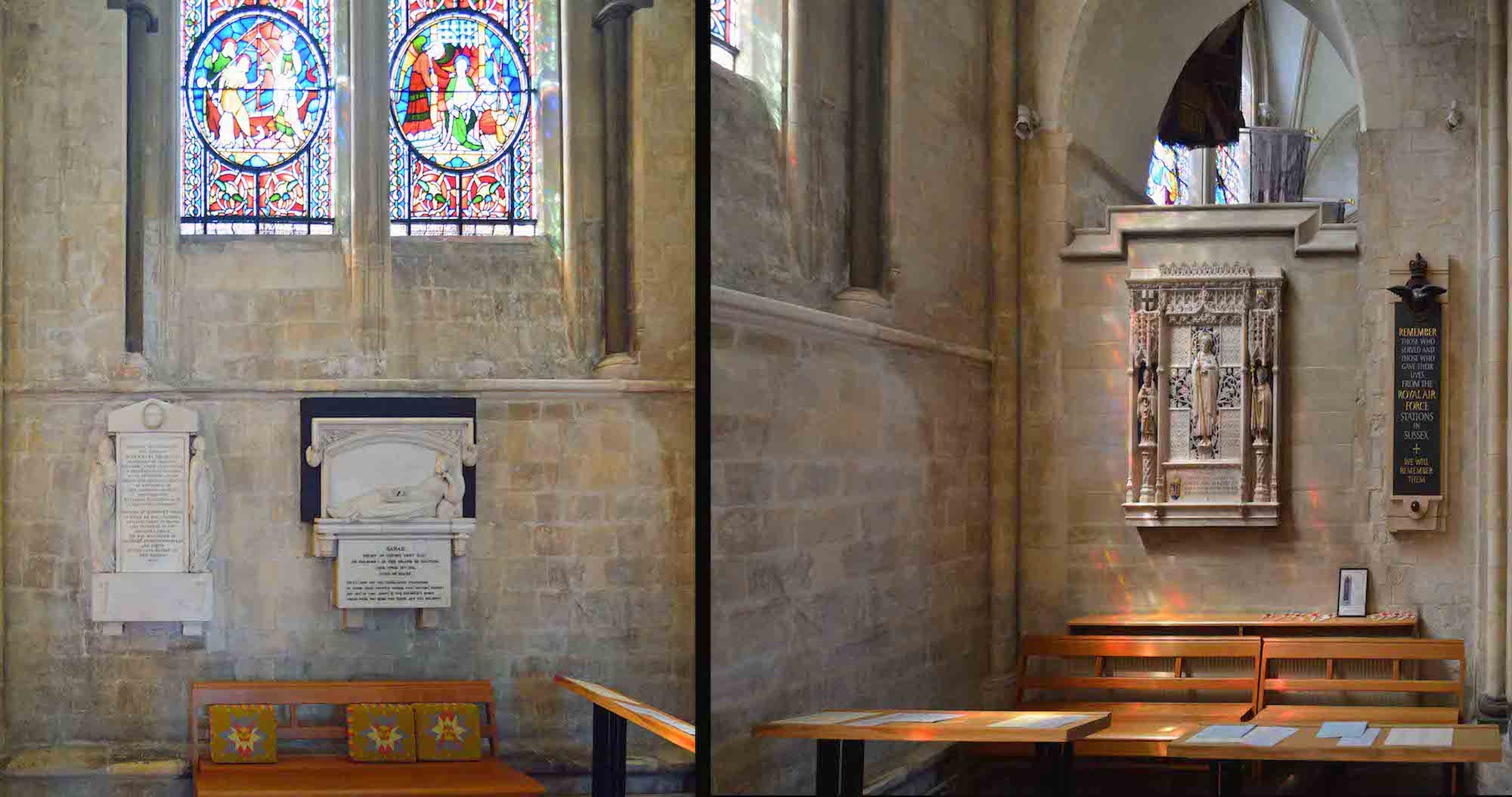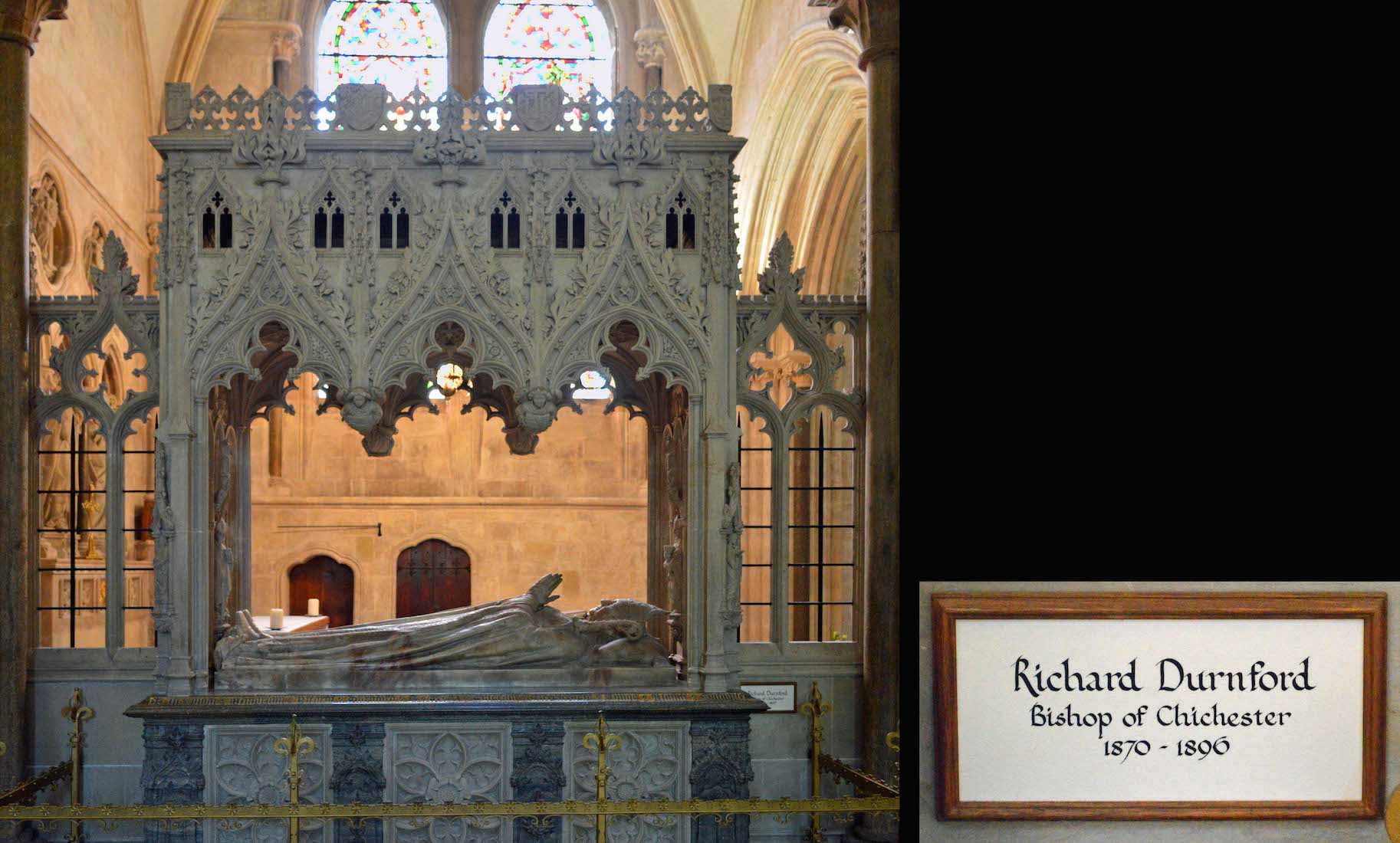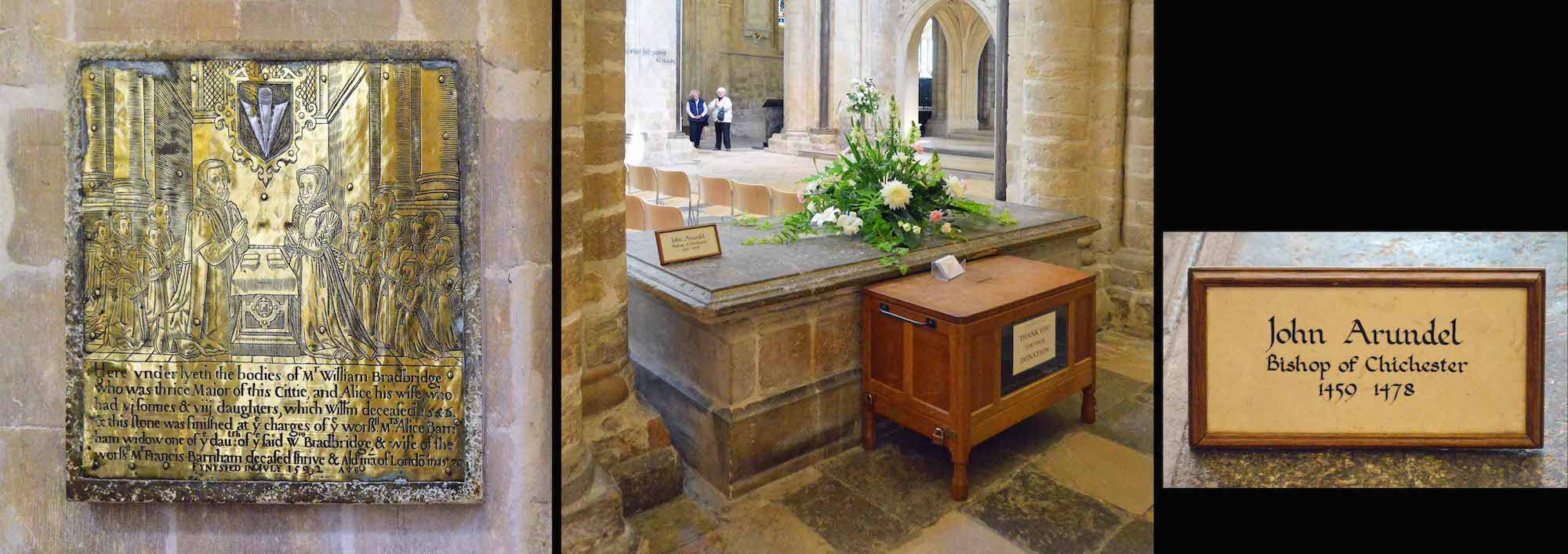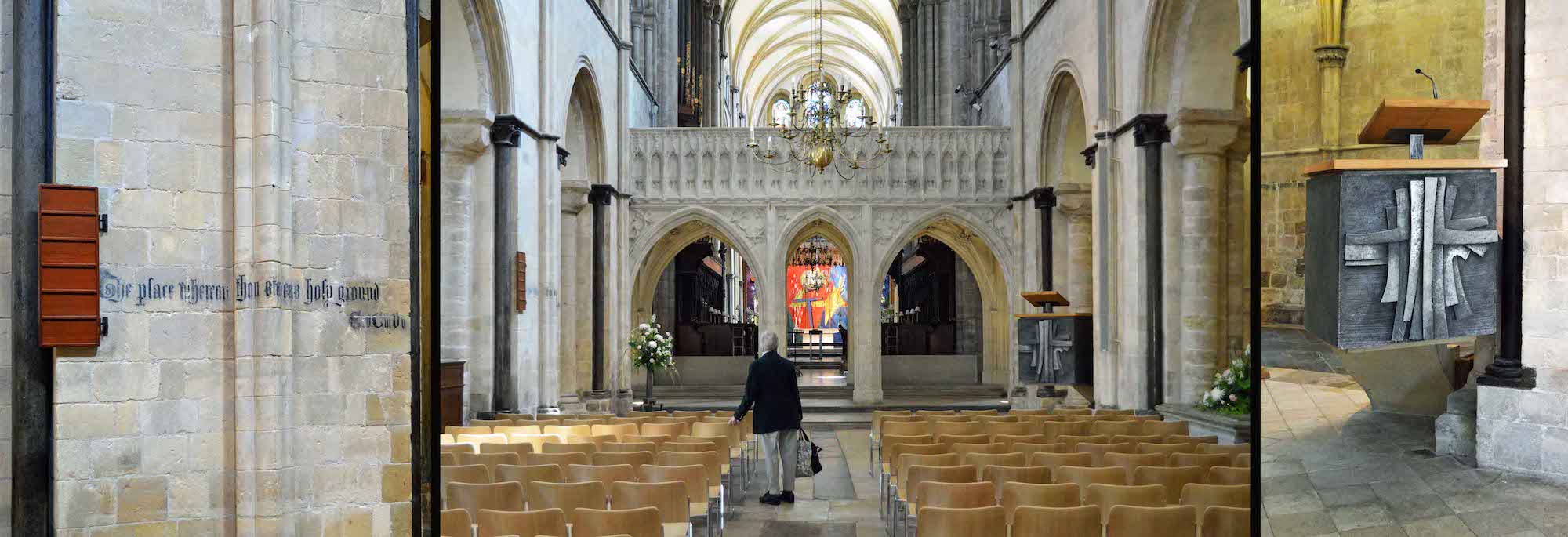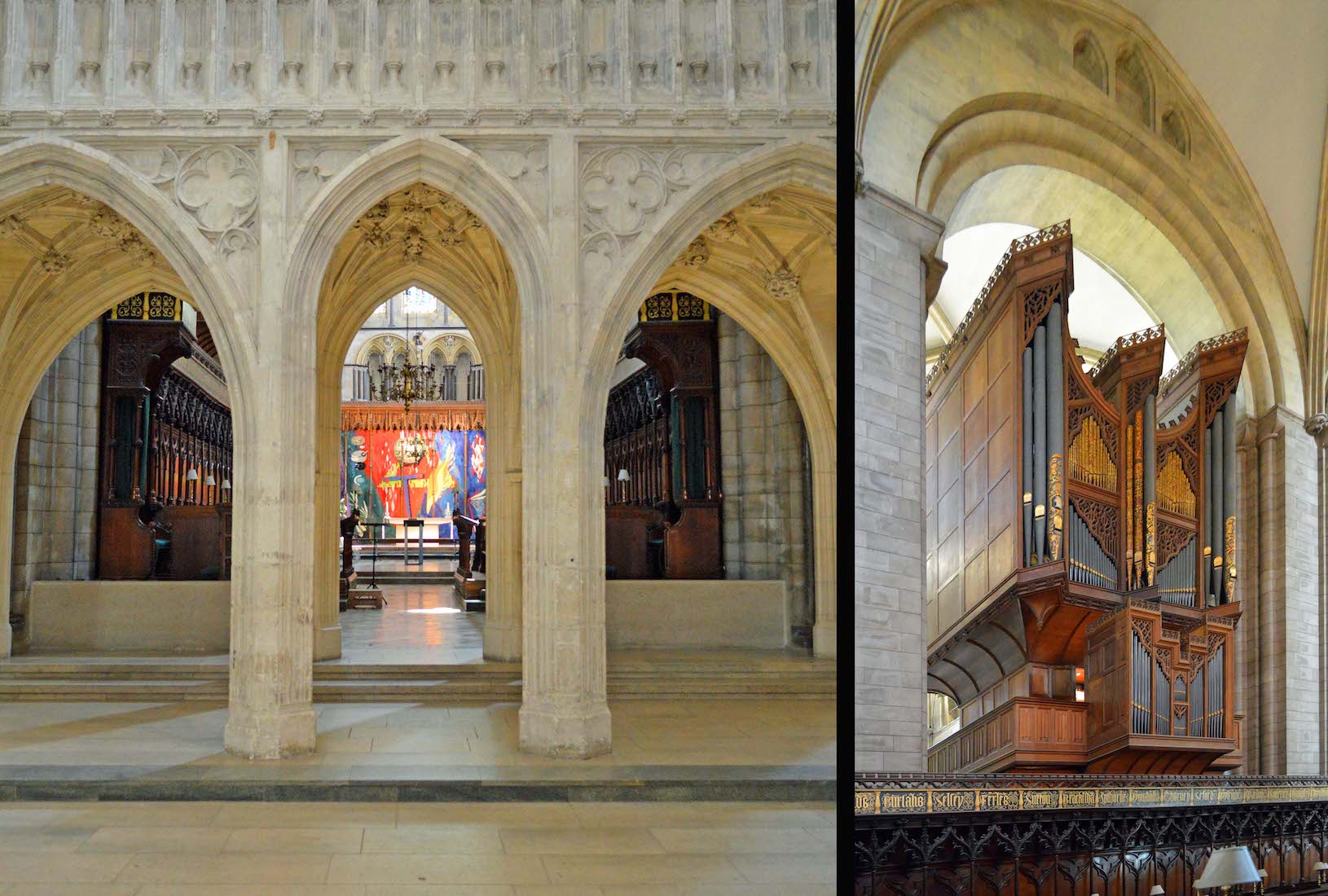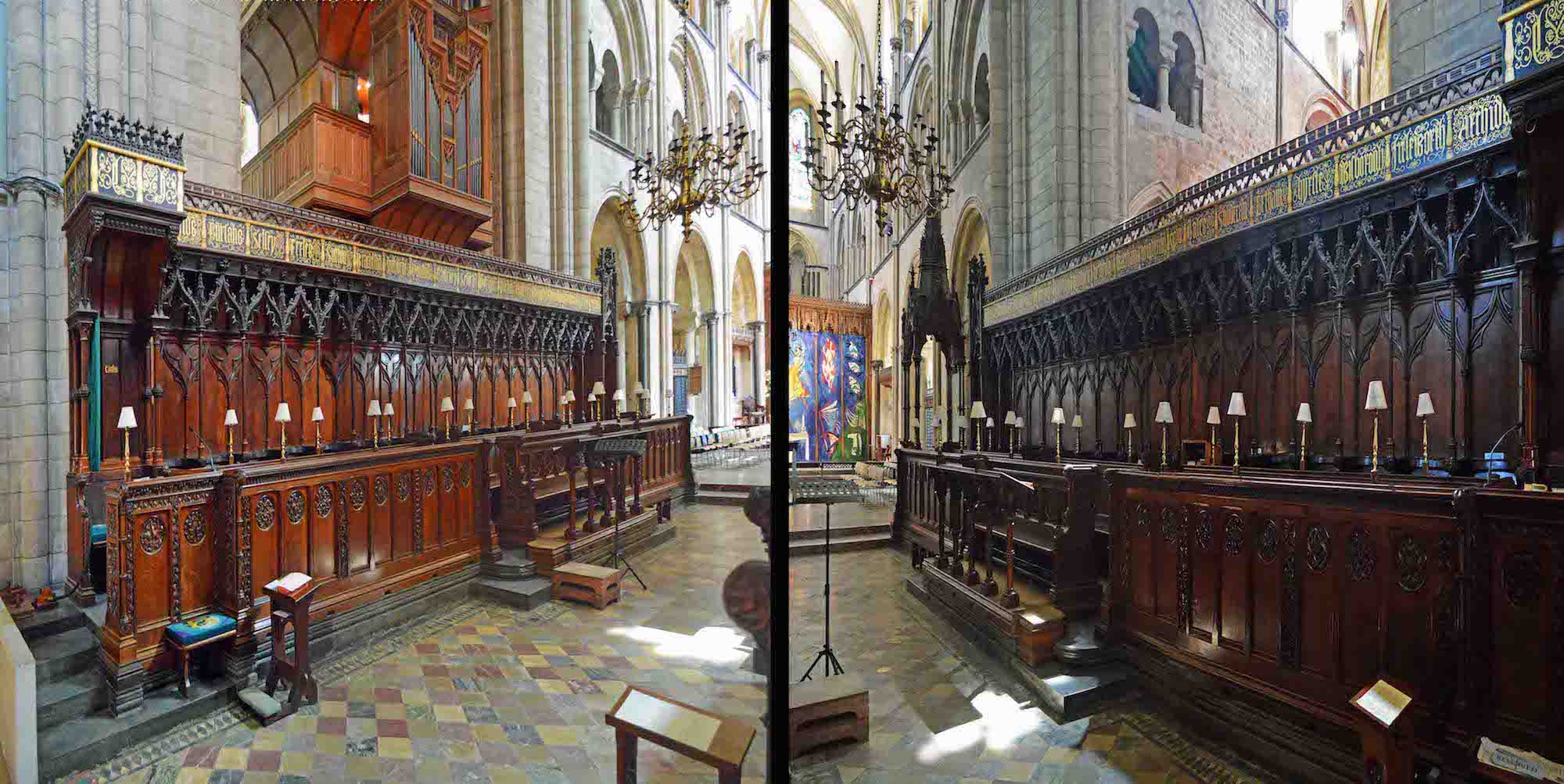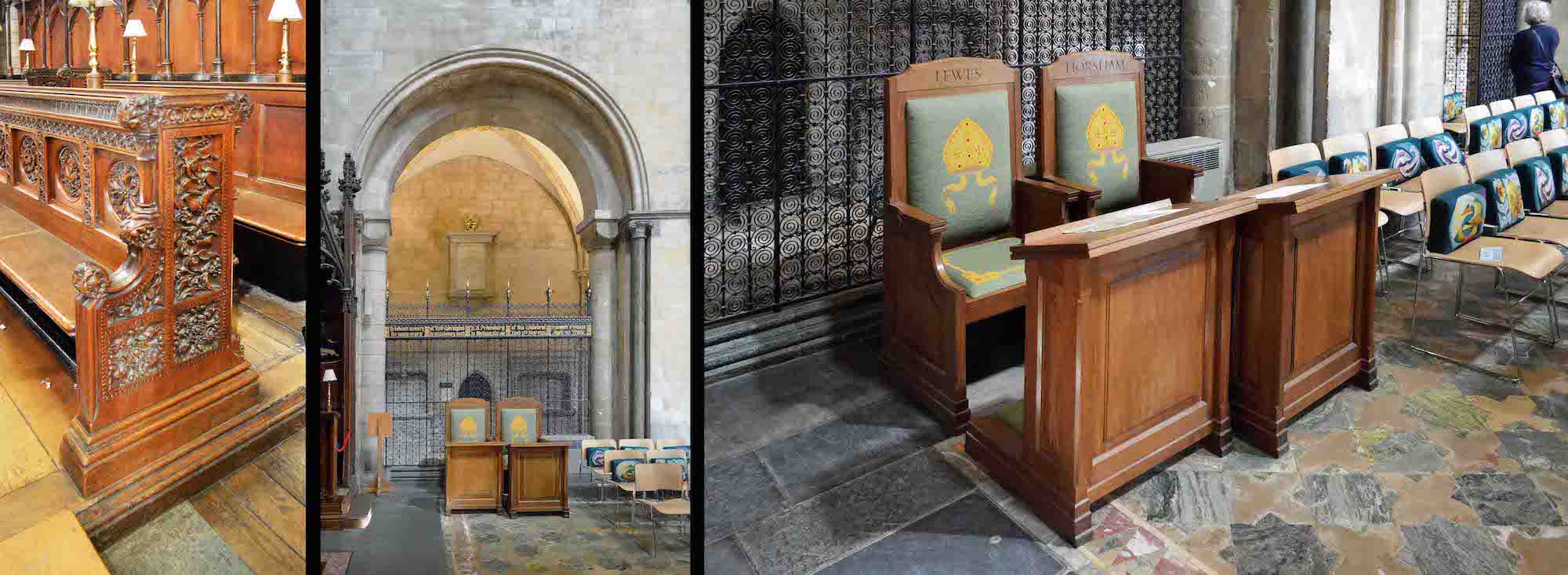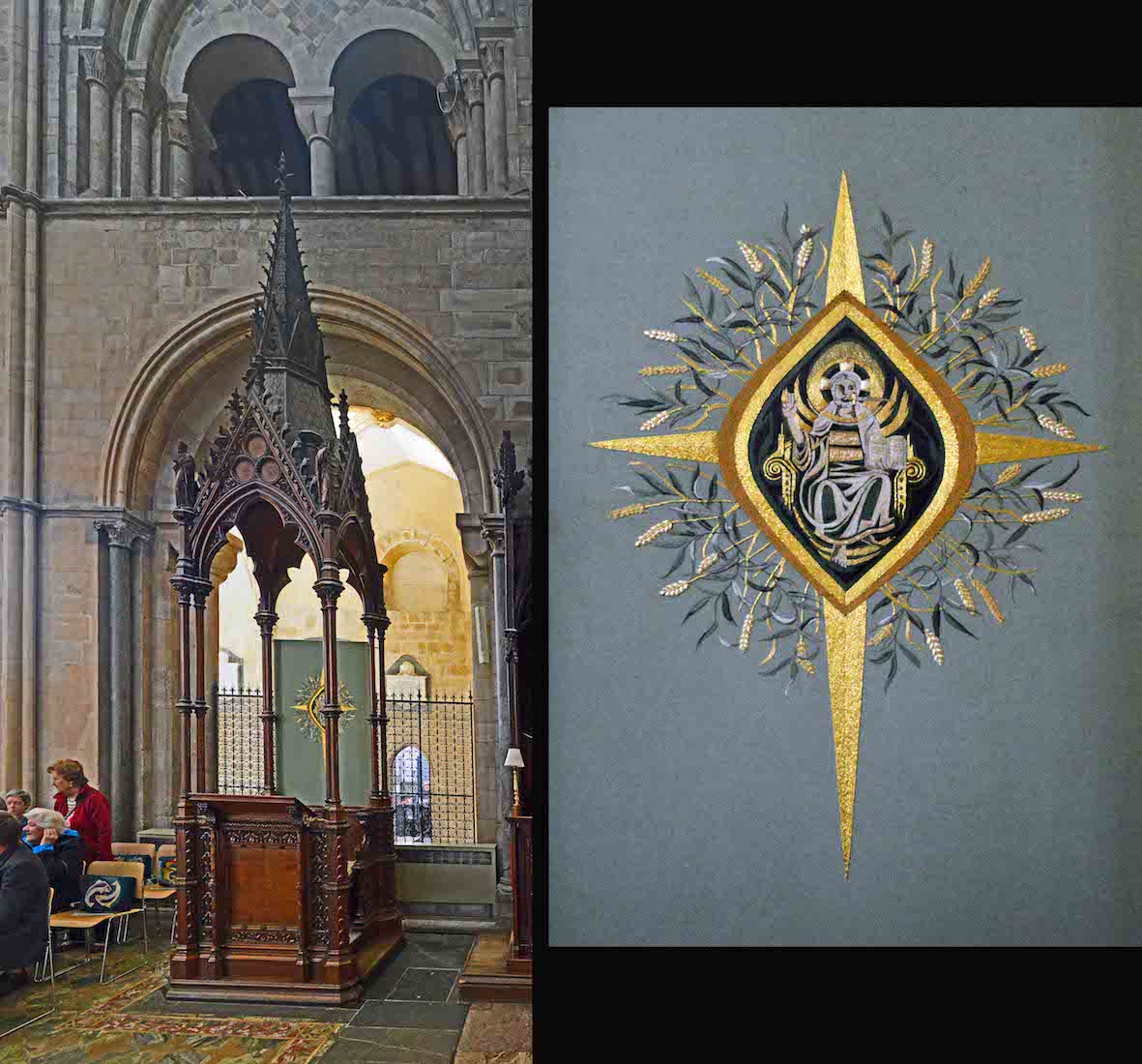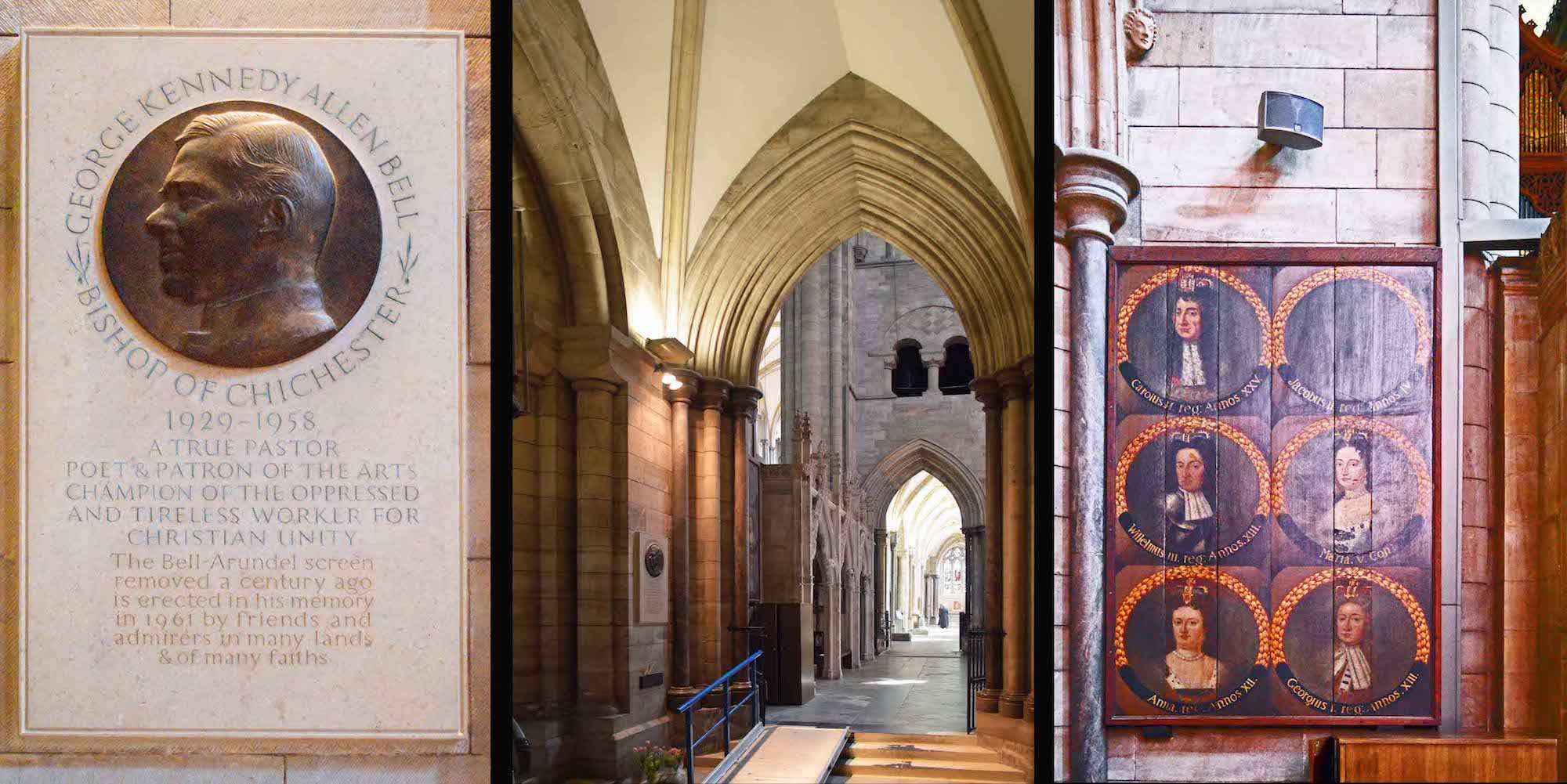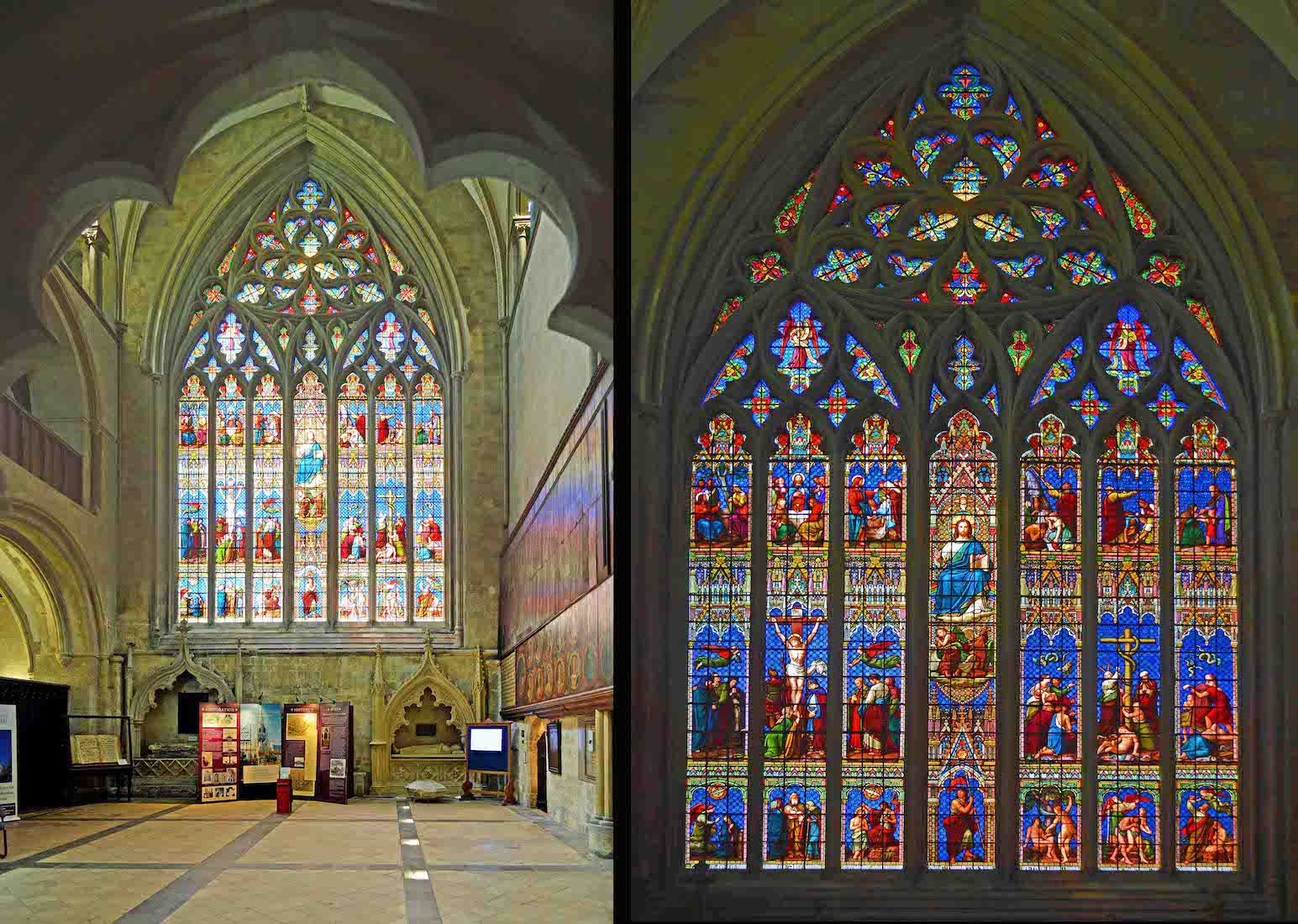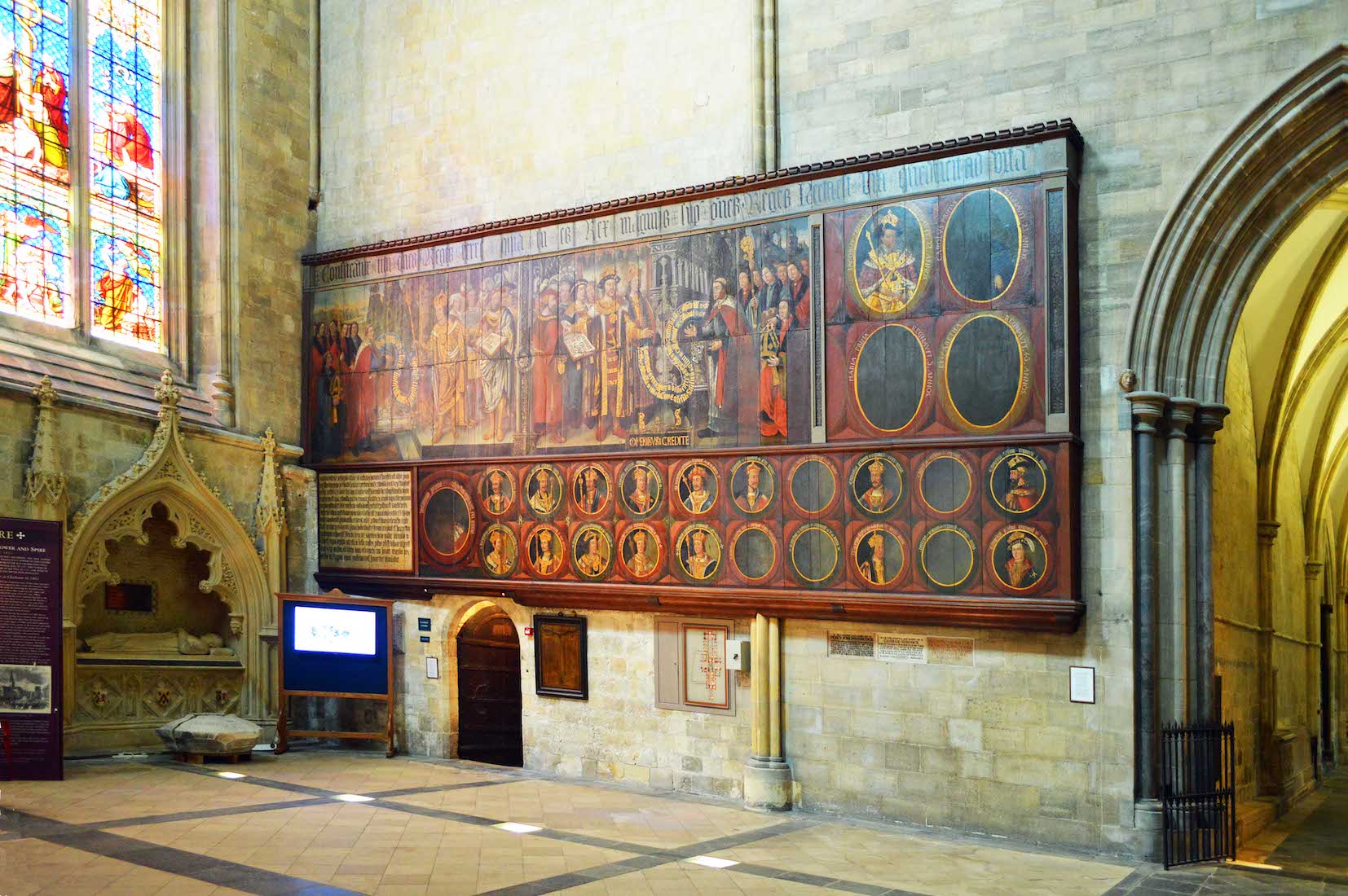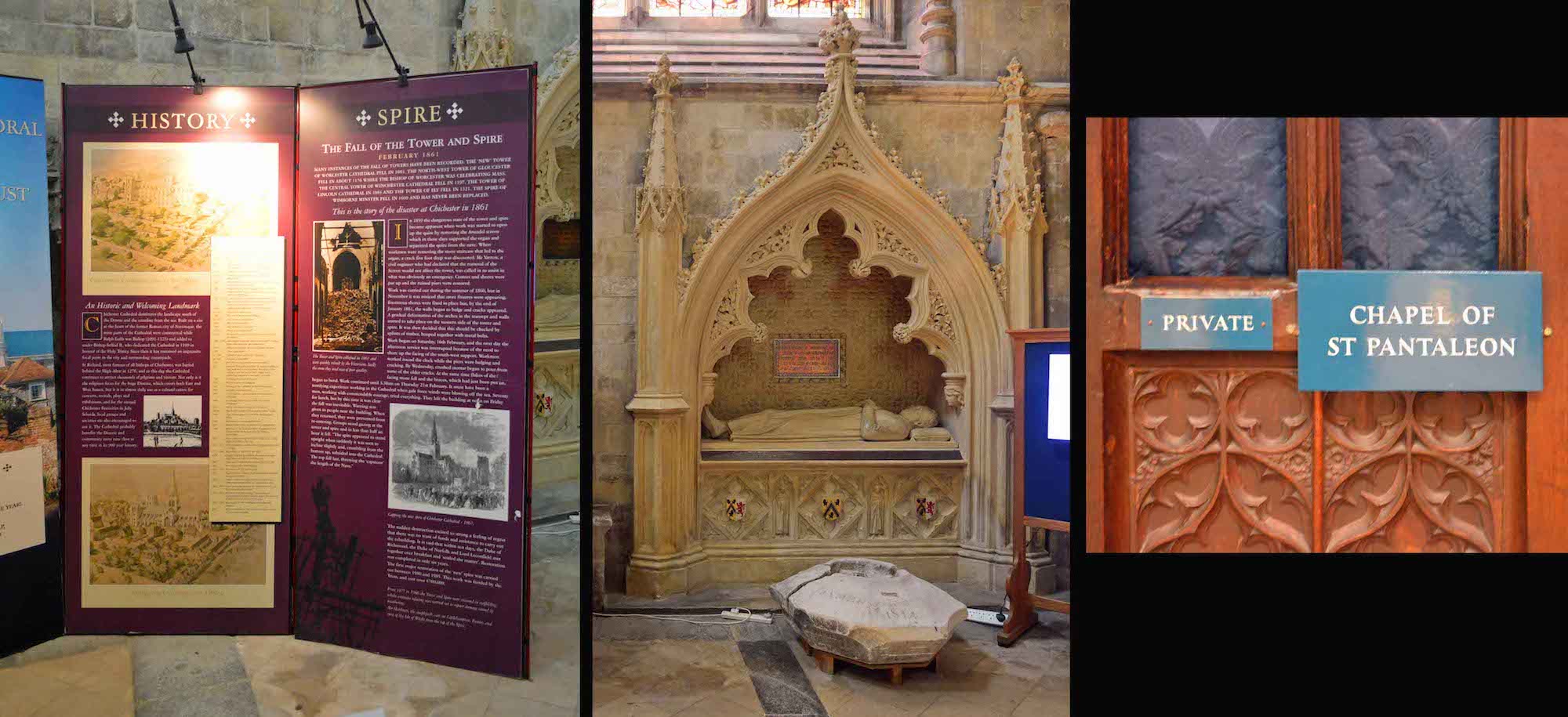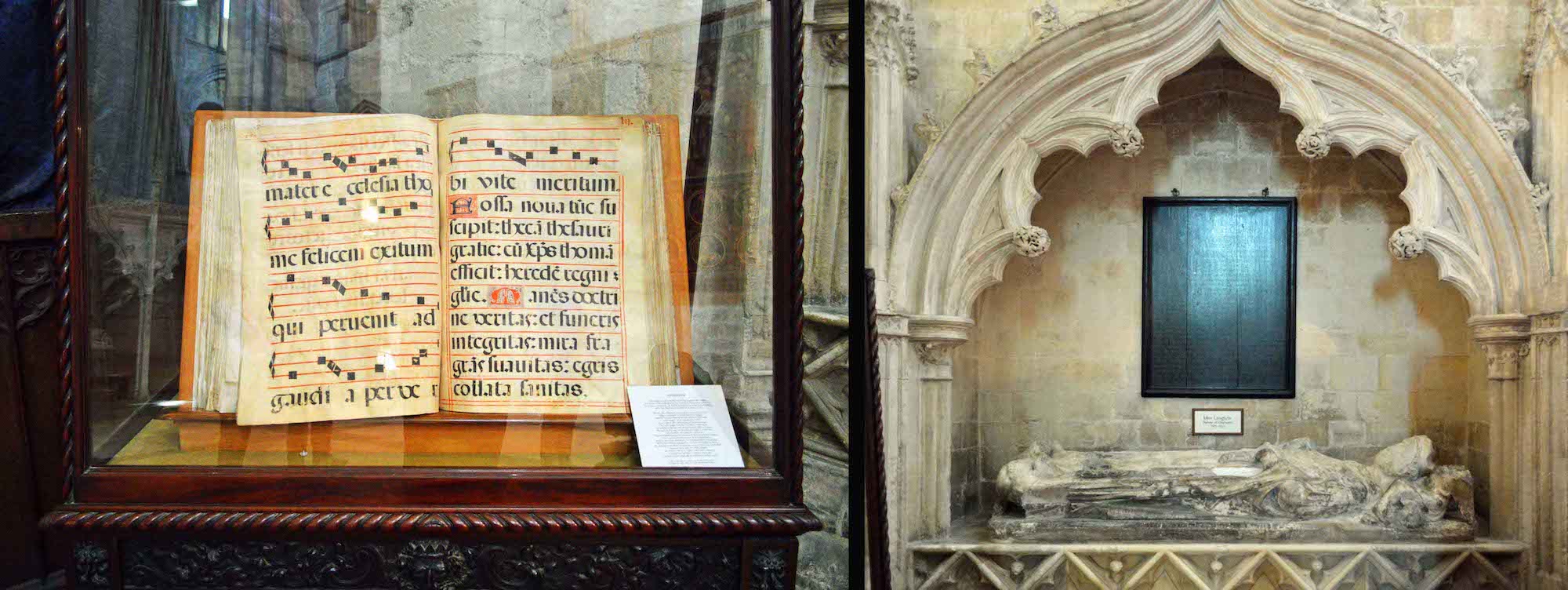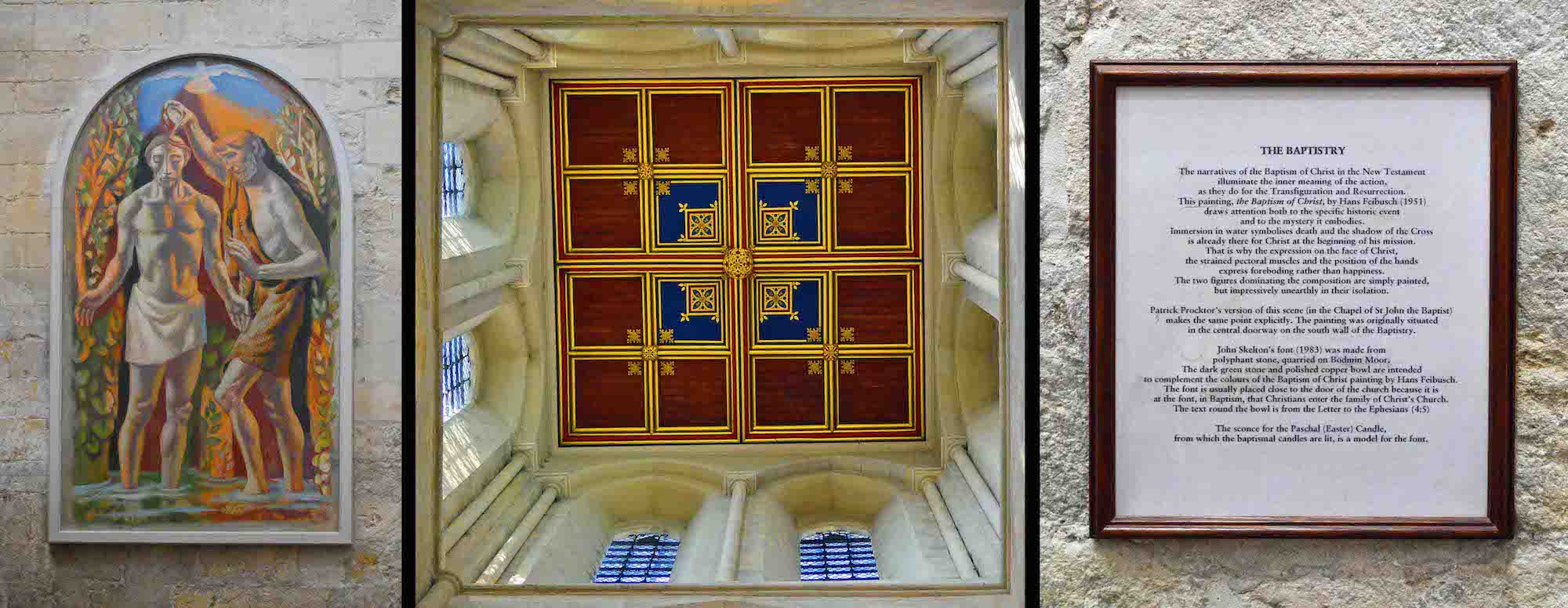
At left is the painting on the West wall of ‘The Baptism of Christ’ by Hans Feibusch (1951). If we look straight up we see the very attractive ceiling of this Southwest tower. There has obviously been some movement over the years! At right is some information about the baptistry. PLAN
22. SOUTH NAVE AISLE
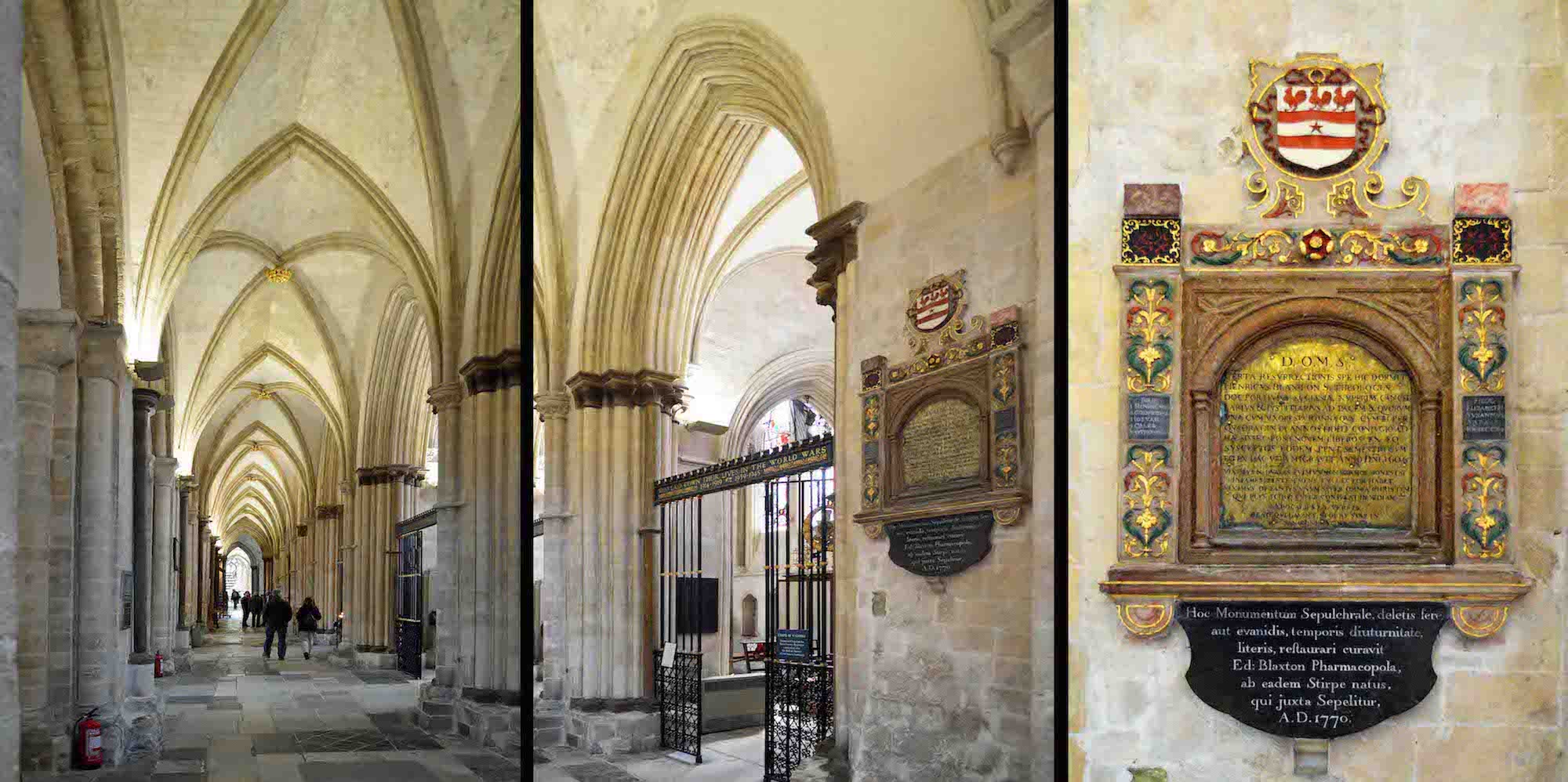
Leaving the baptistry we move to the South nave aisle. As mentioned earlier, this has the body of the nave to our left, and, in fact, two chapels to our right. The first chapel, behind the black grill, is the Chapel of St George. On the near column is an ornate memorial to Henry Blaxton (c.1545 – 1606), who was Chancellor of Chichester Cathedral, and was buried in the Cathedral in 1606. The memorial is also to Henry’s wife Joan. The text is surmounted by the arms of the Blakiston family (from whom he was descended) and flanked by carved pilasters with the names of the nine children, in Latin.
23. CHAPEL OF ST GEORGE
We enter the Chapel of St George, a chapel of some military significance. The chapel probably dates from around 1300. The altar is to the East, and here hang the colours of the Royal Sussex Regiment commemorating action between 1859 and 2000. At left we catch a glimpse of an Honours Roll which is found in this chapel.
24. CHAPEL WINDOWS
In the Chapel of St George there are two windows, each window having two lights. The Eastern window (left) shows the Acts of St John. It is by Arthur O’Connor and donated by Edward Johnson in 1870 in memory of his mother. The Western window (right) shows the Acts of St Paul and was installed in 1852 by John Hardman to a design by Augustus Pugin. It was given by Canon Pilkington in memory of his parents.
25. CHAPEL REREDOS AND HONOUR ROLLS
The painting on the reredos graphically show St George slaying the dragon. The Honour Rolls displayed here give the names of those officers and men of the 3rd, 4th, 6th, 7th and 9th Battalions of the Royal Sussex Regiment who gave their lives in combat.
26. CHAPEL OF ST CLEMENT
We leave the Chapel of St George and move down to the adjacent Chapel of St Clement. Pope Clement I, also known as St. Clement of Rome, was the third pope. He was martyred in about 98. There are other Saint Clements of whom Clement of Alexandria (died 211–216) was also well known in Britain. He was a distinguished teacher of the early Christian Church. The precise date of the chapel’s construction is unknown.
27. CHAPEL WINDOWS
In St Clement’s Chapel there is a pair of windows, each window having two lights. Each light has two scenes. These appear to show (left to right, top to bottom): Jesus appearing to his disciples after his resurrection (‘It is the Lord’), Jesus washing Peter’s feet (‘Lord, not my feet only’); Jesus and Peter (‘Feed my sheep’), Peter and the Gentiles (‘Can any man forbid water?’); Jesus preaching from boat, Jesus calling Peter to walk on water; Peter beginning to sink, Peter released from prison.
28. TOWARDS THE REAR OF CHAPEL
There are four memorials shown here. In particular, on the West wall is an impressive memorial to Bishop Ridgeway who was the Bishop of Chichester from 1908 to 1919. Next to this is a RAF memorial in slate and bronze, designed by Donald Buttress and made by Tim Crawley and Eric Marland. It was unveiled on Battle of Britain Day 2006. Above it are the RAF Ensign and Colours of 46 Squadron. Donald is remembered by his likeness on a gargoyle on the North wall, facing the Bell Tower.
29. BISHOP DURNFORD MEMORIAL
We leave the Chapel of St Clement and move back out into the South nave aisle. Between the chapel and the aisle is the memorial tomb of Bishop Richard Durnford. The Rt Rev Richard Durnford (3 November 1802 – 14 October 1895) was the Bishop of Chichester from 1870 to 1895.
30. BRADBRIDGE MEMORIAL AND ARUNDEL TOMB
Close by is this brass plate remembering Mayor Bradbridge. The brass reads: 'Here under lyeth the bodies of Master William Bradbridge, who was thrice Mayor of this City, and Alice, his wife, who had six sons and eight daughters, which William deceased 1546 etc. ... ’. Continuing East along the south aisle, we pass on our left the tomb of John Arundel – Bishop of Chichester 1459 – 1478.
31. ARUNDEL SCREEN
The Arundel screen, which was originally built with stone from Caen in the fifteenth century, is built across the chancel arch at the Cathedral crossing. The screen gets its name from Bishop John Arundel (1459-78) who was believed to have been responsible for its installation. At left is a hymn board with text: ‘The place wheron thou stand is holy ground.’ At right is the pulpit of modern design, made by Geoffrey Clarke (1966) from cast aluminium.
32. THROUGH TO THE QUIRE
Through the central arch we come to the quire. Above us to the left is the large organ. This contains pipework by many famous English builders, including Renatus Harris, George Pike England and the Hill family. Originally mounted on the rood screen, it was moved to the North transept shortly before the disastrous collapse of the spire in 1861, thus escaping serious damage. In its final form, the organ has three manuals and 35 stops, although a small fourth manual had been prepared for by Hill, but never installed.
33. QUIRE STALLS
The quire stalls embody thirty eight misericords dating from around 1330, though much of the panelling and upper work of the stalls dates from nineteenth century restoration. Chichester Cathedral Choir consists of fourteen choristers, four probationers educated at the Prebendal School and six lay vicars who are professional musicians.
34. SPECIAL SEATING
We appreciate the carving in the quire stalls, and notice some special seating. The names Lewes and Horsham refer to subdivisions of the diocese. The diocese originally had two archdeaconries created in the 12th century, namely that of Chichester and that of Lewes; a third archdeaconry was created in 1912 at Hastings. The archdeaconries were then reorganised under Eric Kemp (Bishop of Chichester) in 1975 with the Archdeaconry of Lewes being merged with that of Hastings and a new archdeaconry at Horsham being created.
35. CATHEDRA
At the East end of the South quire stalls stands the cathedra, seat of the Bishop of Chichester. The insignia on the throne was created by the Cathedral embroiderers, called The Seffrid Guild. It shows the Risen Christ seated at the centre of a cross, surrounded by shoots of wheat.
36. APPROACHING THE SOUTH TRANSEPT
We leave the nave and climb the few steps up to the South transept. On our left is a memorial to George Bell, Bishop of Chichester 1929 – 1958: obviously a much loved leader. Ahead of us on our left is a small panel of old kings and queens, with heads painted on wooden planking.
37. SOUTH TRANSEPT WINDOW
This magnificent window of seven lights tells the story of salvation, from the disobedience of Adam and Eve, (bottom right) to the Resurrected Christ in glory in the centre, with the symbols of the four gospel writers at his feet. It is an example of a ‘Type and Anti-type’ window in which incidents from the Old Testament (Types) are used to foreshadow events in the New Testament. The stonework of the window was constructed in the time of John Langton (Bishop 1305-37), probably replacing smaller windows of Romanesque design. The glass is of a more recent date and was installed in 1877.
38. SOUTH TRANSEPT: PAINTED PANEL
This is one of two huge Tudor paintings by Lambert Barnard (1485 - 1567). Measuring 14ft by 32ft, these painted wooden panels are believed to be the largest surviving paintings of their kind and are of national importance. The paintings contain images of Kings and Queens, and of King Henry VIII conferring Royal protection on Chichester Cathedral. The content of these panels represents a sophisticated piece of political theatre and propaganda, and offers a rare opportunity to imagine how Henry VIII may have been envisaged by his ordinary subjects, in contrast to the courtly art of the period.
39. TRANSEPT CORNER
We find these items in the Southwest corner of the transept. The information board has interesting facts about the history of the Cathedral and the spire. The tomb memorial is for John Smith (1848). John Smith (1767 – 1842) was a British politician who sat in the House of Commons from 1806 to 1835 and a banker. Perhaps the 1848 date refers to the erection of the memorial. The Chapel of St Pantaleon was located where the present Canons’ Vestry now is – through the door under the painted panel. St Pantaleon was counted amongst the late-medieval Fourteen Holy Helpers!
40. OTHER ITEMS
Also along the South wall of the transept is this antiphoner, and the tomb memorial of Bishop John Langdon (1362). The memorial is an effigy on a (partly restored) tomb chest. An antiphonary is one of the liturgical books intended for use in choro (i. e. in the liturgical choir), and originally characterized, as its name implies, by the assignment to it principally of the antiphons used in various parts of the Roman liturgy. In current usage ‘Antiphoner’ refers more narrowly to books containing the chants for the Divine Office.


